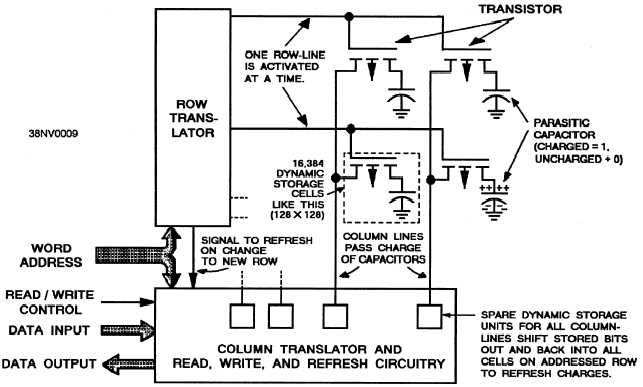Figure 6-32.—DRAM storage cell.
column lines using switching circuitry in the column
selector section. A read/write control tells memory
whether to read or write.
The dynamic RAM cell is less complex than a static
cell because it does not use a latch to store data. A
parasitic capacitors formed in the integrated circuit and
this becomes the storage element, as pictured in figure
6-32. The single transistor switch is used to isolate or
select one particular cell from the entire memory array.
Because the basic dynamic cell design is simple and
contains few elements, it is possible to achieve much
higher densities than with static cell designs.
A typical memory system may be formed from
many 16K word dynamic RAM parts. These parts are
usually structured as 16K by 1, or 16,384 words of only
one bit each. Larger memory words are made by
ganging as many chips as required. This allows greater
flexibility for system designers to organize memory
systems with a small or wide data bus (for example,
16K by 8, 16K by 16, or 16K by 32). Circuit boards
that are extremely cost-effective for large mainframes
are easily created with densely packed dynamic RAM
parts.
Power consumption by dynamic RAM is another
advantage over static RAM. Because the dynamic
RAM cell does not use a latched design to hold data as
do the static RAM parts, the power consumed by each
cell is negligible when it is not being accessed. Most of
the power consumed occurs during a read or write
operation and a small amount is consumed during the
refresh cycle.
The lower power consumption of
dynamic RAM leads to lower cooling requirements and
smaller power supplies because of the reduced memory
power needs.
One disadvantage that a dynamic RAM has is the
need to refresh the entire memory array within a certain
period of time (usually two milliseconds). The DRAM
memory cells do not retain their charged state for more
than a few milliseconds. DRAM cells are subject to
degradation due primarily to time and temperature. To
retain information, the content of each memory cell
must be refreshed before the charge dissipates. The
memory array may be refreshed in one of two ways:
externally or internally. Externally is more cost
effective because a single refresh address generator is
shared by the entire memory array. A type of DRAM,
time volatile memory (TVM) uses a battery backup to
maintain refresh for 30 minutes after the computer has
been powered down or power has been lost.
In our explanation of dynamic RAM organization
and operation, we use two examples to discuss the
architecture, address selection, and read/write/refresh
6-25


